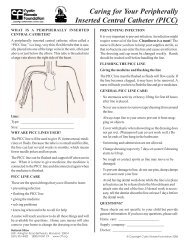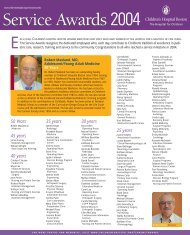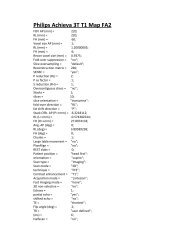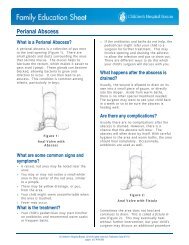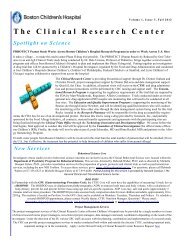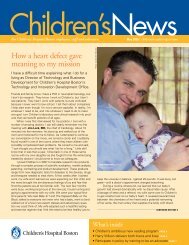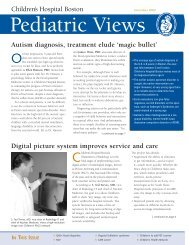cancer and a cure - Children's Hospital Boston
cancer and a cure - Children's Hospital Boston
cancer and a cure - Children's Hospital Boston
Create successful ePaper yourself
Turn your PDF publications into a flip-book with our unique Google optimized e-Paper software.
Doctors today use<br />
three main tools in<br />
their fight against<br />
<strong>cancer</strong>: surgery,<br />
radiation <strong>and</strong><br />
chemotherapy. The<br />
sidebars describe<br />
the experiences<br />
that Chris Johnson<br />
<strong>and</strong> Mary Coffin<br />
have had with<br />
those treatments.<br />
Surgery<br />
Chris has undergone<br />
three surgeries to<br />
remove the original<br />
tumor <strong>and</strong> two<br />
recurrences. The<br />
third surgery was<br />
done with intraoperative<br />
MRI (see page<br />
18). Chris is now<br />
missing about a<br />
quarter of his brain.<br />
Mary had one<br />
surgery to remove<br />
the brain tumor <strong>and</strong><br />
a biopsy of her<br />
spinal tumor.<br />
16<br />
tumors face the same difficulty: the desire to do whatever<br />
it takes to <strong>cure</strong> a child’s disease must be weighed against<br />
the all-too-real physical consequences of attaining that<br />
<strong>cure</strong>.<br />
But there is hope. Today at Children’s <strong>Hospital</strong><br />
<strong>Boston</strong>, diagnostic tools allow tumors to be detected<br />
sooner <strong>and</strong> more accurately; new technologies help surgeons<br />
remove as much tumor as possible without damaging<br />
healthy tissue; radiation <strong>and</strong> chemotherapy are more<br />
precise; <strong>and</strong> the human genome has been decoded, raising<br />
the possibility that <strong>cancer</strong> can be detected <strong>and</strong> treated<br />
at its most basic level. But the question remains: Will any<br />
of this make a difference?<br />
Inelegant solutions<br />
While progress has been relatively rapid for other childhood<br />
<strong>cancer</strong>s such as acute lymphoblastic leukemia,<br />
which now has survival rates of more than 80 percent,<br />
inroads have come more slowly for brain tumors. Even<br />
though they continue to be relatively rare—with fewer<br />
than 2,000 new cases diagnosed nationwide in children<br />
each year—brain tumors are now the leading cause of<br />
death from childhood <strong>cancer</strong>.<br />
And these numbers don’t take into account the side<br />
effects of treating the disease. Adults with brain tumors<br />
who are treated with the three traditional <strong>cancer</strong><br />
therapies of surgery, chemotherapy <strong>and</strong> radiation can<br />
expect an array of problems ranging from hair loss <strong>and</strong><br />
nausea to vision problems <strong>and</strong> seizures. But the same<br />
treatments in children—whose brains are still<br />
developing—can also have a significant effect on<br />
cognitive <strong>and</strong> physical development.<br />
The facts about current treatments speak for themselves:<br />
A recent National Cancer Institute survey of more<br />
than 1,800 children with brain tumors—all of whom survived<br />
at least five years—found that nearly a third<br />
suffered seizures <strong>and</strong> blackouts; 37 percent had headaches<br />
<strong>and</strong> migraines; a sizable minority suffered hearing loss or<br />
blindness; 70 percent diagnosed before age 3 required special<br />
education or learning-disabled classroom settings;<br />
<strong>and</strong>, largely because more children are surviving their<br />
original tumors, secondary tumors caused by radiation<br />
<strong>and</strong> chemotherapy are on the rise.<br />
It is because of these after-effects that brain tumor<br />
specialists find themselves tiptoeing through a minefield,<br />
trying to balance the benefits of each treatment against its<br />
side effects. The ability to attain clear <strong>and</strong> concise<br />
pictures of the tumor <strong>and</strong> the healthy brain around it is<br />
hampered by the fact that children often can’t sit still for<br />
the hour or more it takes to complete a magnetic<br />
resonance imaging (MRI) scan. The desire to surgically<br />
remove the entire tumor is tempered by caution, lest<br />
areas that control speech or other essential functions be<br />
taken out as well. And the hope of destroying <strong>cancer</strong> cells<br />
with radiation <strong>and</strong> chemotherapy is balanced against the<br />
fear of damaging healthy cells as well.<br />
The tales of two tumors<br />
The experiences of two Children’s patients illustrate this<br />
balancing act <strong>and</strong> prove that with brain tumors, solving<br />
one side of the Rubik’s Cube is not enough.<br />
Eight years ago, Chris Johnson was the 12-year-old<br />
all-star catcher for his town baseball team when he started<br />
seeing two pitches coming at him instead of one. At<br />
first he was told the cause was dehydration, then a sinus<br />
infection. But the double vision <strong>and</strong> headaches didn’t go<br />
away, so Chris had an MRI that revealed an orange-sized<br />
tumor on his temporal lobe.<br />
He was diagnosed with glioblastoma multiforme,<br />
which is, in the words of his oncologist Mark Kieran,<br />
MD, PhD, “arguably the most malignant tumor in<br />
humans.” Fortunately, due to the tumor’s location, it was<br />
able to be removed entirely, <strong>and</strong> despite a median<br />
survival of only seven to nine months, Chris has survived<br />
for more than eight years. In that time, he has had two<br />
recurrences (<strong>and</strong> subsequent surgical removals) in the<br />
same location <strong>and</strong> has undergone several rounds of<br />
chemotherapy <strong>and</strong> radiation. And even though the longterm<br />
side effects of his treatments have been relatively<br />
Dream ❘ Fall/Winter 2002





